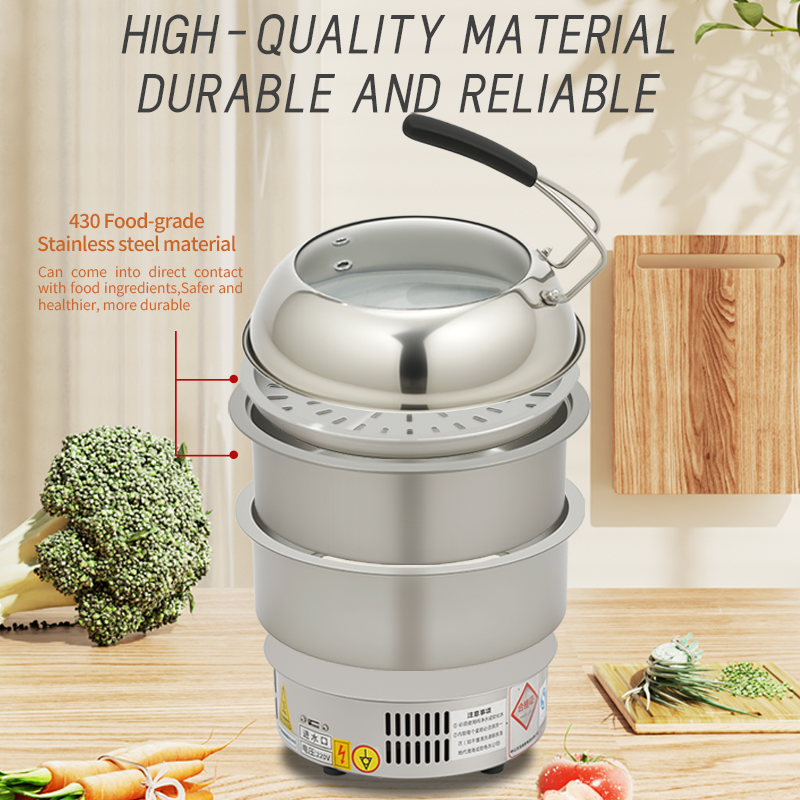Why Choose a Stainless Steel Seafood Steamer?
Seafood steamers are essential tools for both the restaurant industry and home kitchens, especially large stainless steel steamers. They are popular worldwide for their durability, hygiene, and efficiency. With the rise of healthy eating trends, steaming seafood has become a new favorite because it preserves its original flavor and nutrients. This article will provide an in-depth analysis of its functions, market trends, and how to optimize costs.
I. Core Features of a Stainless Steel Seafood Steamer:
Professional Cooking Experience
1. Efficient Multi-Layer Design
◦ Large Capacity: The large steamer (20-40 liters) can simultaneously steam lobster, crab, shellfish, and more, perfect for banquets.
◦ Evenly Distributed Heat: 304 stainless steel conducts heat quickly, and the tiered steaming rack prevents food from accumulating, preserving its freshness and tenderness.
2. Intelligent Temperature Control and Safety
◦ A constant temperature control system prevents overcooking, a transparent lid allows for easy inspection, and a scald-proof handle and automatic power-off feature enhance safety. 3. Multifunctional expansion ◦ Compatible with induction cooktops and gas stoves. Some models support steaming, boiling, and stewing, saving space with one pot.
II. Seafood Steamer Market Analysis:
Driving Factors of Surge in Demand
Catering Industry:
Global seafood restaurant industry sees 12% annual growth (2023 data). Mid-range and high-end restaurants and seafood specialty stores are expected to see growth.
Home Kitchens:
Household penetration in Europe and the United States has increased by 35%. Healthy cooking has become mainstream, and seafood steamers are becoming the preferred choice for large families and health enthusiasts.
Commercial Use:
Hotels and cruise ships are increasing their purchases of seafood steamers, emphasizing batch processing efficiency and being a key choice for large-scale catering supply chains and hotel kitchens.
Seafood Steamer Market Size:
Globally $1.85 billion in 2023, projected to reach $2.68 billion in 2028 (CAGR of 7.2%).
Upgrading seafood consumption and the rise of healthy cooking. Regional Growth: Asia-Pacific leads the market (45%), with North America experiencing 9% annual growth and Europe experiencing a steady 6% growth. Southeast Asia's tourism and catering industry is expanding, while European and American home kitchens are upgrading. Category Share: Large commercial steamers (30L+) account for 68%,
medium-sized household steamers account for 32%. Demand for batch processing is surging in the catering industry.
III. Seafood Steamer Market Trends: Four Major Directions for Future Development
1. Intelligent upgrade: Wi-Fi remote control and AI temperature adjustment functions are becoming increasingly popular.
2. Environmentally friendly materials: The proportion of food-grade stainless steel (304) has increased, and it is more corrosion-resistant.
3. Customized design: Modular layered steaming racks are suitable for different food sizes.
4. Emerging market growth: The demand for seafood steamers in Southeast Asia and the Middle East has increased by 20% annually, and the seafood consumption culture has spread.
IV. Cost savings: Three major benefits of long-term investment
1. Reduced energy consumption
◦ The sealed design of the stainless steel steamer reduces steam leakage, saving 30% of electricity and 25% of gas consumption compared to traditional steamers. 2. Optimized maintenance costs
◦ Stainless steel is rust-resistant and has a lifespan of more than 10 years; detachable parts are easy to clean, reducing labor time.
3. Improved food utilization
◦ The seafood steamer's precise temperature control reduces steaming errors and reduces seafood loss by 15%, making it particularly suitable for high-priced lobsters and king crabs.
V. Frequently Asked Questions (FAQs)
Q1: Do stainless steel steamers easily retain fishy odors?
No! 304 stainless steel is highly resistant to adsorption and can be easily cleaned with lemon water or white vinegar, making it superior to aluminum steamers.
Q2: Are large steamers suitable for home use?
Yes! Stainless steel steamers have multi-layer designs that can be flexibly disassembled. A single layer is suitable for small families, and the capacity can be expanded for gatherings, making them more cost-effective.
Q3: How should I choose a commercial-grade seafood steamer?
Three key points to consider:
Capacity: Seafood steamers over 30 liters with a reinforced base;
Certification: NSF/CE food safety mark;
Accessories: Seafood steamers come standard with anti-scalding clips and a drip tray.
Q4: Can a steamer be used to steam other ingredients?
Of course! Stainless steel seafood steamers are suitable for vegetables, dim sum, and even Chinese dumplings. The versatility of a seafood steamer reduces equipment purchase costs.
VI. Risk Warning and Strategic Recommendations for Stainless Steel Steam Pots
1. Policy Risks:
◦ The EU will implement a new energy efficiency standard for kitchen equipment in 2024, requiring thermal efficiency to reach 85% or higher (currently 70% of products require upgrades).
2. Raw Material Supply Chain Risks for Stainless Steel Steam Pots:
◦ Nickel price fluctuations (accounting for 35% of costs): Futures hedging is recommended to lock in the price.
3. Strategic Actions for Stainless Steel Steam Pots:
◦ Deepening the Application Sector: Developing corrosion-resistant seafood steamers specifically for fishing vessels (1000-hour salt spray test).
◦ Expanding the Channel: Establishing an assembly plant in Southeast Asia to avoid the 25% tariff.
Return on Investment Calculation for Seafood Steam Pots:
• High-end smart steamers with a factory price of US$120 and a retail price of US$299 can achieve a payback period of 8 months for catering customers (saving energy and reducing food waste).
VII. Technological Evolution of Seafood Steam Pots and the Threat of Substitutes
1. Innovations in Seafood Steamers
Energy-saving technology: Vacuum insulation reduces heat loss (reducing energy consumption by another 15%)
Material revolution: Aviation-grade titanium alloy steamers (half the weight, 20+ years of life, 3 times the cost)
Smart IoT: Huawei's HarmonyOS integrated into steamers, enabling voice-controlled steaming curves
VIII. Changing downstream demand scenarios for seafood steamers
1. New demands in the catering industry
Efficiency upgrades:
Seafood steamers with automatic loading systems (such as Japan's integrated catering robot solution, which reduces labor by 40%)
Stainless steel steamers will have modular designs: Industrial-grade steaming cabinets capable of processing 100 lobsters at a time (a necessity for cruise ship kitchens)
Compliance requirements:
NSF/CE certification has become a mandatory requirement for European and American procurement, increasing certification costs for Chinese manufacturers by 8-10%
Cost sensitivity of seafood steamers: Fluctuations in 304/316L stainless steel prices (influenced by nickel and chromium futures)
• Cost reduction strategies: Chinese manufacturers are shifting to 430 stainless steel and 304 composite base plates (maintaining strength, reducing costs by 12%)


